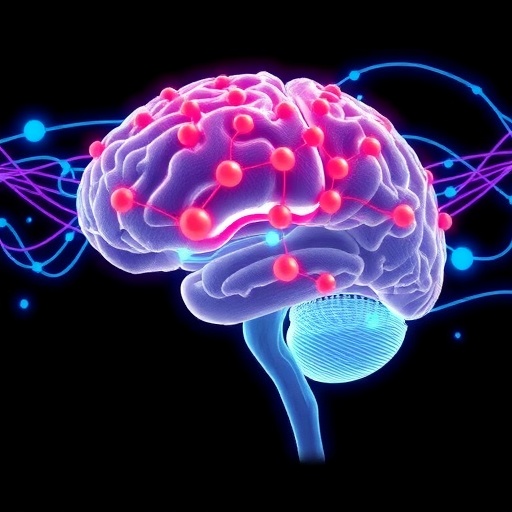In the evolving landscape of neuromodulation therapies, deep brain stimulation (DBS) has emerged as a transformative approach for a host of debilitating neurological disorders, particularly Parkinson’s disease and dystonia. Yet, the precise cellular and synaptic mechanisms that underpin the therapeutic efficacy of DBS have long eluded researchers. A groundbreaking study published recently in Nature Neuroscience sheds new light on this mystery, revealing that differential synaptic depression is a key mediator of the clinical benefits offered by DBS. This pioneering work offers a compelling mechanistic framework that could revolutionize how we refine and personalize DBS interventions for neurological disorders.
DBS involves the targeted delivery of electrical impulses to specific brain regions, usually via implanted electrodes, with the intent of modulating neural activity. While clinical outcomes have been promising, the underlying mechanism—whether it involves excitation, inhibition, or a complex interplay of synaptic dynamics—has remained contentious. Li, Zhou, He, and colleagues have now unveiled that synaptic dynamics, specifically synaptic depression distinctively impacting excitatory and inhibitory pathways, orchestrate the therapeutic effects of DBS in a defined neural circuit model.
At the heart of this investigation lies a sophisticated interrogation of synaptic transmission properties under DBS-like stimulation patterns in neuronal circuits implicated in movement regulation. The researchers applied precise electrophysiological assays combined with optogenetic manipulations to dissect how high-frequency stimulation differentially modulates synaptic efficacy at excitatory and inhibitory synapses. It was astonishing to observe that while excitatory synapses underwent a pronounced depression in response to continuous stimulation, the inhibitory synapses displayed a resilience or a different profile of synaptic weakening, leading to a fundamental rebalancing of network activity.
This nuanced differential depression translates into a restoration of functional equilibrium within the affected neural networks, essentially recalibrating aberrant circuit dynamics that are hallmarks of disorders like Parkinson’s disease. The authors propose that this recalibration via synaptic depression dampens pathological hyperactivity without globally silencing brain regions, a finding that reconciles previous conflicting hypotheses about DBS effects being purely excitatory or inhibitory.
The cellular basis of this phenomenon involves critical presynaptic mechanisms governing neurotransmitter release probability and vesicle pool dynamics. High-frequency stimulation exhausts readily releasable pools more efficiently at excitatory terminals, precipitating a buildup of synaptic depression. In contrast, inhibitory terminals either preserve release probability or engage different synaptic vesicle recycling pathways, thereby manifesting differential fatigue properties. This discovery implicates specific molecular targets such as synapsins and voltage-gated calcium channels that differentially modulate synaptic transmission and plasticity in the distinct synapse types.
Beyond synaptic physiology, computational modeling was leveraged to simulate network-level consequences of these synaptic depressions. Simulated neural network behavior reaffirmed that differential synaptic depression reshapes firing patterns to favor more normalized, stable output signals, aligning with clinical observations of symptom alleviation during DBS treatment. This integrative approach combining bench and in silico methodologies underscores the power of multi-level investigations to untangle complex neurotherapeutic phenomena.
Moreover, the research highlights potential therapeutic avenues extending beyond electrical stimulation. By pinpointing the synaptic dynamics critical to therapeutic efficacy, pharmacological agents can be developed to mimic or enhance synaptic depression selectively at excitatory synapses or to bolster inhibitory synaptic resilience. Such targeted pharmacotherapies, used alongside DBS or as standalone options, could enhance efficacy or reduce side effects associated with electrical stimulation.
The implications of this study also extend to the optimization of DBS stimulation parameters. Currently, stimulation frequencies and intensities are mostly empirically derived or adjusted manually based on clinical feedback. Understanding the synaptic depression profiles provides rational criteria to tailor stimulation protocols that maximize beneficial synaptic rebalancing while minimizing energy consumption and adverse effects. This could revolutionize closed-loop DBS systems that dynamically adjust stimulation in real time based on synaptic state readouts.
On a broader scale, the fundamental insight into how differential synaptic depression governs circuit dynamics may inform treatment strategies in other brain disorders where dysregulated excitation-inhibition balance is critical, such as epilepsy, depression, and obsessive-compulsive disorder. DBS applied to distinct brain targets in such disorders could now be optimized by leveraging principles revealed by this study.
The use of advanced technologies such as optogenetics, electrophysiology, and computational neuroscience to unravel these complex synaptic phenomena reflects a tour de force in contemporary neurobiological research. This integrative approach not only elucidates DBS mechanisms but also advances fundamental understanding of synaptic plasticity and its role in disease and health.
Looking forward, further studies are needed to validate these findings in human neurons and in vivo models that recapitulate the full complexity of neuronal networks involved in DBS-treated disorders. Additionally, longitudinal investigations into how chronic DBS influences long-term synaptic plasticity and structural connectivity will be vital to optimize durable therapeutic interventions.
Such mechanistic revelations underscore the importance of synapse-level precision in evaluating and developing neuromodulation therapies. By peering into the synaptic microcosm and decoding the language of synaptic depression, we edge closer to personalized, fine-tuned brain stimulation therapies that offer hope for millions suffering from neurological ailments.
In conclusion, this seminal work by Li and colleagues not only clarifies a fundamental biological process underlying DBS’s remarkable therapeutic effects but also paves the way for a new generation of neuromodulation strategies informed by synaptic physiology. As deep brain stimulation continues to transform clinical neurology, understanding its synaptic underpinnings promises to unlock unprecedented improvement in efficacy and the development of innovative therapeutics. The future of neurotechnology now rests on the fine balance of synaptic depression—ushering a new era where electrical impulses and synaptic plasticity combine to restore brain harmony.
Subject of Research: Mechanisms mediating the therapeutic effects of deep brain stimulation, focusing on differential synaptic depression in excitatory and inhibitory synapses.
Article Title: Differential synaptic depression mediates the therapeutic effect of deep brain stimulation.
Article References:
Li, J., Zhou, J., He, B. et al. Differential synaptic depression mediates the therapeutic effect of deep brain stimulation. Nat Neurosci (2025). https://doi.org/10.1038/s41593-025-02088-w
Image Credits: AI Generated




